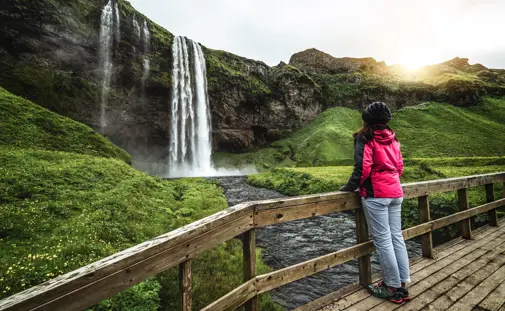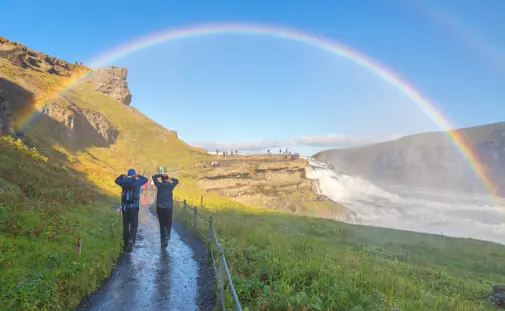Lake Mývatn, located in northern Iceland, is one of the country's most stunning lakes and geologically fascinating natural wonders. This shallow, eutrophic lake is surrounded by a landscape shaped by volcanic activity, making it a hotspot for natural beauty and scientific interest. The name "Mývatn" translates to "Midge Lake," due to the swarms of midges that populate the area, which are an essential part of the lake’s rich ecosystem.
The area around Lake Mývatn is renowned for its diverse landscapes, including the otherworldly lava formations of Dimmuborgir, the pseudocraters at Skútustaðir, and the bubbling mud pots and steaming vents at Námaskarð. The geothermal activity in the region has also created the Mývatn Nature Baths, a popular destination for relaxing in warm, mineral-rich waters while enjoying panoramic views of the surrounding countryside.
Lake Mývatn is a haven for birdwatchers, with over 13 species of ducks nesting in the area, making it one of the most important breeding grounds in Europe. The area’s natural beauty, unique geology, and vibrant wildlife make Lake Mývatn a must-visit destination for nature lovers and those seeking to experience the raw, unspoiled beauty of Iceland.
Lake Mývatn Facts
Lake Mývatn is notable for its geological, ecological, and historical significance. Here are some important facts and figures about the lake:
-
Surface area: 37 km² (14 sq mi)
-
Average depth: 2.5 meters (8 ft 2 in)
-
Maximum depth: 4.5 meters (15 ft)
-
Surface elevation: 288 meters (945 ft)
-
Lake type: Volcanogenic, eutrophic
-
Age: Formed approximately 2,300 years ago following a massive basaltic lava eruption
-
Water temperature: 10–15°C (50–59°F) during summer months
-
Location: Positioned within Iceland's active volcanic zone, east of Akureyri and southwest of Húsavík.
History and Formation
Lake Mývatn comes from volcanic origin, which goes back more than 2,300 years. The big basaltic flows of lava shaped the area into a shallow lake with nutrient-rich waters, fostering a eutrophic ecosystem. The surrounding landscape is dotted with craters, pseudo-craters, and lava formations, all testaments of the volcanic genesis of the region.
The nearby Krafla volcano, part of the same volcanic system, still has its say in molding geology. It last erupted from 1975 to 1984 and gave this area a dramatic touch, adding to the otherworldly landscape of Lake Mývatn. Its shallow waters teem with one of the most unique features regarding birdlife; thus, it has become one of the best places in Europe for bird-watching, especially ducks.
Wildlife
Lake Mývatn is famous for its rich biodiversity, especially in relation to its birdlife. This lake hosts one of the largest breeding colonies of ducks in Europe, with over 13 species that regularly nest around its shores, including the tufted duck and Barrow's goldeneye. The area supports other species of waterfowl, waders, and passerines. This place is considered a true birdwatcher's paradise.
Besides, its nutrient-rich waters are home to a very large number of aquatic insects, which in turn draws in the birdlife. Trout and Arctic char are abundant in the lake; hence the fishing is good. Wetlands around it, together with volcanic terrain, provide variety in the habitat for a wide range of flora and fauna.
Beware of Midges
One of the most recognizable aspects of Lake Mývatn, mainly during the warmer periods of the year, is midges: small flies that do not bite. In fact, the name "Mývatn" itself means "Midge Lake." They are totally harmless but at certain times of late spring and summer can be overwhelming in number. However, with the right gear, such as a midge head net, you can enjoy your visit without too much trouble. Just as with Iceland's unpredictable weather, being prepared is key to a pleasant experience.
In Iceland there’s also a new type of midge that bites called lúsmý in icelandic (Culicoides reconditus). Fortunately there’s been little reporting of the biting midges at lake mývatn that seems to be dominated by the non-biting lake midges.
Sites Around Lake Mývatn
Lake Mývatn is full of different sites to see, all very unique and special in its own way. They are great for hiking and offer views over the volcanic landscapes of Iceland.
Vindbelgjarfjall Mountain
Vindbelgjarfjall offers wide panorama views over Lake Mývatn and is a great hiking location. It will take about 2 to 3 hours for a medium difficulty hike. Its trail is ideal for those wanting to catch the scenery from above with views over the surrounding lava fields and their craters.
Skútustaðagígar Craters
These pseudocraters formed when lava laid over this marshland, and steam explosions blew through to the surface. The area is dotted with small craters, and visitors can take short hikes around the area. This is also a popular spot for bird watching.
Kálfaströnd Area and Höfði
Höfði is a lovely nature reserve on the east shore, affording great views over Lake Mývatn with short, easy walks through the lava formations and woodland areas. The Kálfaströnd peninsula offers great views over the lake, especially at sunset.
Dimmuborgir Lava Field
Also known as "The Dark Castles," Dimmuborgir is a place of fantastic lava landscapes, complete with towering lava pillars and caves. It is good to hike around the area and explore the eerie landscape, which is steeped in folklore.
Stóragjá Fissure
Stóragjá is a fissure near the lake and in old times was a geothermal bathing site, but the water quality has been changing frequently, which forbids bathing here nowadays, although it is still an interesting spot to visit.
Where is Lake Mývatn?
Lake Mývatn is located in the northern part of Iceland, roughly 100 km east of Akureyri. It’s in the region known for its volcanic landscapes, geothermal activity, and spectacular natural beauty. Its proximity to several major tourist routes makes it an ideal destination for those exploring North Iceland.
-
GPS coordinates: 65.6°N, 17.0°W
How to Get to Lake Mývatn?
From Reykjavík:
Lake Mývatn is approximately 480 km from Reykjavík, making for a 6-7 hour drive via Route 1, the Ring Road. Travelers can also take a domestic flight to Akureyri and then drive about 90 minutes to reach Mývatn.
From Akureyri:
Lake Mývatn is 90 km east of Akureyri, and the drive takes around 1.5 hours along the Ring Road (Route 1). The journey offers stunning views of North Iceland's rugged landscapes.
From Höfn:
The drive from Höfn to Lake Mývatn is around 330 km and takes approximately 4-5 hours. The route takes you through some of the most scenic parts of Iceland, including mountain passes and stretches along the eastern fjords.
From Egilsstaðir:
Lake Mývatn is 165 km west of Egilsstaðir, and the drive takes about 2.5 hours via Route 1.
Can I See the Northern Lights from Lake Mývatn?
Lake Mývatn is often called "Iceland’s Northern Lights capital" due to its location away from major sources of light pollution. The area also benefits from a microclimate, which often results in clearer skies, offering excellent conditions for Northern Lights viewing. Visitors during the aurora season (September to April) are likely to experience one of the best spots in Iceland for witnessing this natural phenomenon.



